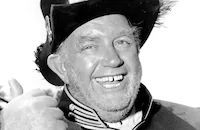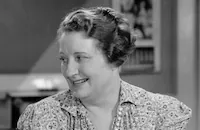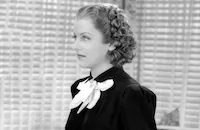Chance at Heaven

Brief Synopsis
Cast & Crew
William Seiter
Ginger Rogers
Joel Mccrea
Marion Nixon
Andy Devine
Lucien Littlefield
Film Details
Technical Specs

Synopsis
After two years of dating, Blackstone "Blacky" Gorman, the owner of a gas station in the resort town of Silver Beach, Massachusetts, finally proposes to Marje Harris, his devoted girl friend. Soon after, however, the wealthy, pretty Glory Franklyn moves to Silver Beach with her family, and the moment she sees handsome Blacky, she falls in love. Blacky falls for Glory's deliberate, youthful charms, and allows himself to be swayed by her teary tales of parental tyranny. Wise to Blacky's activities and feelings, Marje nobly terminates their engagement, freeing him to propose to Glory. Although her status-conscious mother strongly disapproves of Blacky, Glory elopes with him and moves into his small house, an act of defiance that fuels the gossip columns and makes Blacky an overnight celebrity. Because she still loves Blacky, Marje happily instructs the childish Glory on how to be a proper housewife, redecorating the house with her and even showing her how to make Blacky's favorite dish, chicken pie. When Glory discovers she is pregnant, however, she panics, suddenly realizing the seriousness of the marriage "game," and flees to New York to be with her mother. After several months of separation, Blacky learns from Marje that his wife is leaving for California and rushes to New York to stop her. No longer pregnant, a coldly matured Glory informs Blacky that she wants out of the marriage. Heartbroken, Blacky drifts for a time, but eventually returns to Silver Beach and his faithful Marje.

Director

William Seiter
Cast

Ginger Rogers

Joel Mccrea

Marion Nixon

Andy Devine

Lucien Littlefield
Virginia Hammond

George Meeker

Ann Shoemaker

Herman Bing

Betty Furness
Crew
Jimmy Anderson
Merian C. Cooper
Perry Ferguson
Julien Josephson
Sarah Y. Mason
James B. Morley
Nick Musuraca
Forrest Perley
Van Nest Polglase
Max Steiner
H. N. Swanson

Film Details
Technical Specs

Articles
Chance at Heaven
The story, based on Vina Delmar's Chance at Heaven, published in Liberty magazine's April 9, 1932 edition, was unusual, even for pre-Code Hollywood: Marje (Rogers) falls in love with gas station owner Blacky (Joel McCrea) and they become engaged. When the more glamorous rich girl Glory (Marian Nixon) arrives on the scene, she sets her sights for Blacky and the noble Marje steps aside. Glory and Blacky wed and it is Marje who helps Glory set up her house and tutors her on how to be a proper wife. In time the marriage breaks up and Marje gets her man. For Ginger Rogers, the film was memorable only because her co-star, Joel McCrea, was good friends with Rogers' current boyfriend (and future husband) Lew Ayers.
There were some cast and crew changes before production began, with William Seiter replacing Al Santell as director and Marian Nixon replacing Dorothy Wilson as Glory. Stage veteran Laura Hope Crews (best known as Aunt Pittypat in Gone With the Wind, 1939), was mentioned by The Hollywood Reporter as being under consideration for a role (most likely that of Glory's mother, which went to Virginia Hammond), but did not appear in Chance at Heaven. McCrea's dim-witted gas station buddy was played by the always reliable Andy Devine, whose wheezy, high-pitched voice would make him a perennial favorite in Westerns in the latter half of the decade, most notably as the stagecoach driver in John Ford's Stagecoach (1939).
Chance at Heaven was quickly shot during August 1933 and was released on December 26th. Mordaunt Hall, in his review for The New York Times, wasn't overly impressed with the film, calling it "an innocuous domestic tangle [...] one of those frail, disarming features in which psychology is considered unimportant. The author and the director see to it that the leading characters fall in love and decide to part without much of an excuse in either case." Hall points out that "Glory, whose ignorance is her only asset, in that it causes her to be more or less amusing, is none too popular with the audience. Even her husband is somewhat of a lout. But Marje evidently knows how to treat such fickle men, for she wins Blacky back, but there is a doubt in one's mind as to whether he will be able to call his soul his own after they are man and wife." Rogers, who Hall praised for her dancing in the recently released Flying Down to Rio (1933), "acts the part better than it deserves", with McCrea giving "quite a satisfactory performance" and Nixon doing "reasonably well" as Glory.
Producer: H.N. Swanson
Director: William Seiter
Screenplay: Sarah Y. Mason, Julian Josephson; Vina Delmar (story "A Chance at Heaven")
Cinematography: Nick Musuraca
Art Direction: Perry Ferguson, Van Nest Polglase
Film Editing: James B. Morley
Cast: Ginger Rogers (Marjorie 'Marje'/'Mug' Harris), Joel McCrea (Blackstone 'Blacky' Gorman), Marion Nixon (Glory Franklyn), Andy Devine (Al), Lucien Littlefield (Mr. Fred Harris), Virginia Hammond (Mrs. S.T. Franklyn), George Meeker (Sid Larrick), Ann Shoemaker (Mrs. 'Mother' Harris).
BW-71m. Closed Captioning.
by Lorraine LoBianco
SOURCES:
AFI Catalog of Feature Film
Hall, Mordaunt "Chance at Heaven: Ginger Rogers, Marian Nixon and Joel McCrea in a Harmless Domestic Tangle" The New York Times 26 Dec 1933
http://www.imdb.com
Rogers, Ginger My Story

Chance at Heaven
Quotes
Funny how a good kick in the pants will make a guy's head work.- Blacky Gorman
Trivia
Marian Nixon replaced Dorothy Wilson in the role of Glory Franklyn.
Notes
The ending of the film is ambiguous concerning the result of Glory's pregnancy. Although her mother states that the doctor was wrong in his diagnosis, the script strongly suggests in other places that she was pregnant and therefore had an abortion. According to Hollywood Reporter news items, Al Santell was originally scheduled to direct the production and Dorothy Wilson and Laura Hope Crews were to have appeared in it. Robert McWade was announced as a cast member in Hollywood Reporter, but his participation in the final film has not been confirmed. Modern sources credit Mel Berns as makeup artist and John Miehle as still photographer on the production and add the following cast members: Harry Bowen (First reporter), Helen Freeman, Thelma Hardwick and Alden Chase.














